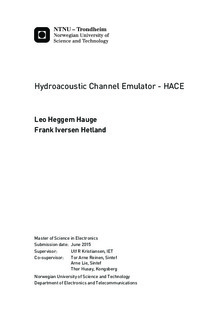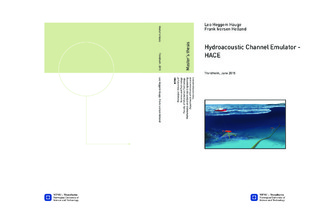| dc.description.abstract | Kongsberg Maritime wanted a channel emulator for testing their hydroacoustic equipment before deploying it at sea. The benefits of such a system are that it detects problems in an earlier phase of development, thus conveniently reducing the number of expensive sea trials necessary. This master thesis describes how a channel emulator with hydroacoustic properties can be made. The emulator will replace the transducers and water with a computer simulating the acoustics, an audio interface and voltage attenuation.
Our approach has been to develop a stable and user-friendly channel emulator with a basis in acoustic wave theory. The hydroacoustic channel emulator, HACE, includes acoustic simulation models where the user is allowed to change acoustic parameters and place the positions of transducers for both point-to-point and network communication. This thesis has focused on advanced acoustic models such as Doppler spread, surface scatter, varying seabed and surface in 3D, sound speed profile with ray tracing, and network communication, together with the fundamental models such as, propagation loss and delay, and reflections.
In order to meet the requirements of this master s thesis, with respect to latency and jitter, a good programming platform is important. MATLAB was chosen due to the huge library of built-in-functions, especially with respect to digital signal processing. To control the system a user interface was created with the focus on simplicity, where the interface allows the user to control the system and adjust parameters.
The real-time requirement for the system was a latency with a maximum of 100 ms. Since the latency is dependent on both software and hardware, and varies from setup to setup, a calibration function was developed to ensure the best performance for each individual system. HACE has full control over the system latency and exploits it when adding the propagation delay. The minimum latency was measured as 34.2 ms, which resulted in a minimum distance between two nodes using a sound speed of 1500 m/s, being 51.3 meters. For the system to model other distances correctly, this latency must be taken into account when adding propagation delay. Ideally, zero latency would have been preferred so that all distances could be simulated.
Two tests were performed to determine the performance of the total system, one that compared the real world impulse response with the simulated impulse response, and secondly to verify the propagation delay in HACE against the measured distance from APOS. The results showed that the simulated ranges corresponded well with the ranges measured in APOS, with an offset of around 20 cm throughout all the results.
Impulse response measurements were performed at a sea trial in Horten (Breiangen) measuring at horizontal ranges from 0 to 3000 meters between two nodes. Results from the sea trial compared with those of HACE showed very good similarities between the two, with time deviations between the first and second arrival being from 0 - 3 ms (0 to 15 %), where the largest deviations were found at the shortest ranges. | |

